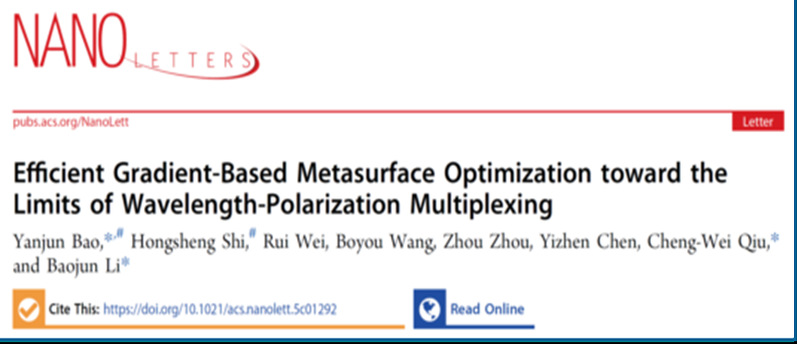- ABOUT JNU
- ADMISSION
-
ACADEMICS
- Schools and Colleges
-
Departments and Programs
- Arts College of
- Chinese Language and Culture College of
- Economics College of
- Electrical and Information Engineering College of
- Foreign Studies College of
- Information Science and Technology College of
- Environment School of
- Humanities School of
- International Business School
- International Studies School of
- Journalism and Communication College of
- Law School
- Liberal Arts College of
- Life Science and Technology College of
- Management School of
- Marxism School of
- Medicine School of
- Pharmacy College of
- Physical Education School of
- Science and Engineering College of
- Shenzhen Tourism College
- Research Institute
- Research Center
- Programs in English
- Majors
- Study Abroad
- Online Learning
- RESEARCH
- CAMPUS LIFE
- JOIN US
Professors Li Baojun and Bao Yanjun Publish Groundbreaking Research on Multidimensional Optical Field Multiplexing on Metasurfaces in Nano Letters
Author:Bao Yanjun
Publisher: College of Physics and Optoelectronic Engineering
Date: April 8, 2025
Researchers at Jinan University have made significant advancements in the field of multidimensional optical field multiplexing on metasurfaces. Professors Yanjun Bao and Baojun Li from the Nanophotonics Research Institute of the College of Physics and Optoelectronic Engineering, alongside Professor Chengwei Qiu from the National University of Singapore, have developed a pioneering gradient optimization algorithm based on deep neural networks. This algorithm notably enhances both computational efficiency and optical performance while approaching the theoretical limits of polarization and wavelength multiplexing channels on metasurfaces. Their findings have been published in the esteemed journal Nano Letters under the title Efficient Gradient Based Metasurface Optimization Towards the Limits of Wavelength Polarization Multiplexing.

(Screenshot of the paper)
Overview of the Research
Abstract:
Polarization and wavelength multiplexing are widely utilized techniques designed to enhance the capacity of metasurfaces. Although prior research has pushed the limits of channel numbers for each technique, simultaneous optimization of both remains a significant challenge. Existing multiplexing methods often suffer from computational inefficiencies, limiting their effectiveness in complex computational tasks.
In this study, the team introduces and experimentally validates a gradient-based optimization algorithm employing deep neural networks (DNNs) to push the boundaries of polarization and wavelength multiplexing with high computational efficiency. By leveraging the capabilities of the DNN-based method, the researchers successfully implemented nine multiplexed channels (three wavelengths × three polarizations) for large-scale image recognition tasks, encompassing a total of 36 classes within a single-layer metasurface. The proposed approach achieved an impressive classification accuracy of 96% in simulations and 91.5% in experimental setups.
This contribution establishes a new benchmark for high-capacity multiplexing, utilizing gradient-based inverse design principles for advanced optical elements, with important implications for the future of optical technology.
For further details, the full paper is accessible at the following link:
https://pubs.acs.org/doi/full/10.1021/acs.nanolett.5c01292
NEWS
- About the University
- Quick Links
Copyright © 2016 Jinan University. All Rights Reserved.




